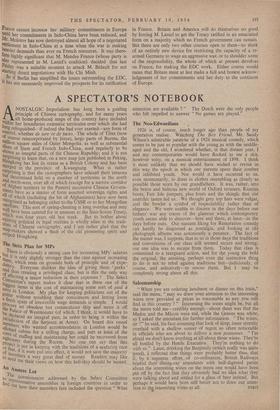A SPECTATOR'S NOTEBOOK
ANOSTALGIC Imperialism has long been a guiding principle of Chinese cartography, and for many years all home-produced maps of the country have included within her boundaries extensive territories over which she had long relinguished—if indeed she had ever exerted—any form of control, whether de jure or de facto. The whole of Tibet (now of course reincorporated by force), large parts of Burma, the million square miles of Outer Mongolia, as well as substantial slices of Siam and French Indo-China, used regularly to be shown as integral parts of the Chinese Republic; and it is not ,surprising to learn. that, on a new map just published in Peking, nongkong has lost its status as a British Colony and has been Merged in the province of Kwangtung. What is rather surprising is that the cartographers have relaxed their tenuous but determined hold on a number of territories in the north and north-west, over all of which (except for a narrow corridor of Afghan territory in the Pamirs) successive Chinese Govern- ments have as a matter of form asserted sovereign rights and all of which (including the bit of Afghanistan) have now been recognised as belonging either to-the USSR or to her Mongolian satellites. This sort of spring-cleaning is long overdue and may well have been catered for in annexes to the Sino-Soviet Treaty, which was four years old last week. But to bother about existing political or legal realities is wholly alien to the tradi- tions of Chinese cartography, and I am rather glad that the map-makers showed a flash of the old pioneering spirit and swiped Hongkong.


































 Previous page
Previous page